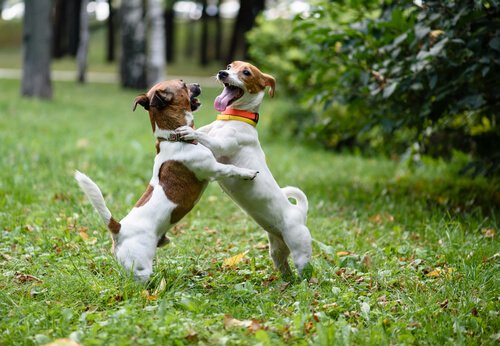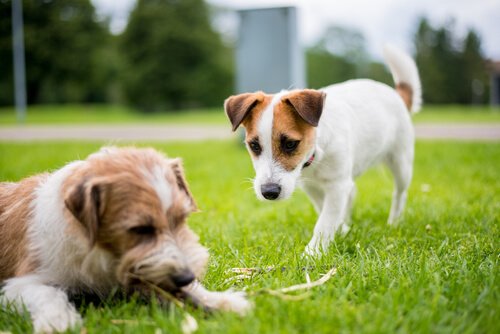Dog Greetings: Everything You Should Know

When you’re at the park with your pet and suddenly you see another dog approaching, how can you tell if they have good intentions? Especially, how do you go about letting your dog greet them? Read this article to find out more about dog greetings.
Types of dog greetings
Some dogs are calm and analyze the situation when another dog approaches them. First, they smell their nose, then their backside, and then they decide if they can trust their new friend and play with him.
Others, on the other hand, “think” less and pounce on the dog next to them. They may jump on them, fondle them or take their toys. There are even some who will want their new friend to run through the park and play with them until they get tired.
Dog greetings can depend on the personality and age of each animal, as well as the training they’ve received. Although you can’t control their personality or age, you do have a say in their training.

How should dogs greet each other?
If you take your pet for a daily walk through the park or another place outdoors, they’ll probably come in contact with other dogs. Therefore, it’s very important that you teach them how to greet new friends, or even “old” ones. To avoid problems with other pets — and of course with their owners — they’ll have to change some of their habits and learn some new ones.
It doesn’t matter if your dog is used to “walking by themselves” on the street. You’ll never know what to expect in the park. There might be a new dog in the neighborhood that your dog is unacquainted with and their desire to smell him may cause a fight.
In this case, putting them on a leash can be a double-edged sword. This is because one of the typical mistakes owners make is tugging on the leash when another animal approaches. You have to be very careful in this moment because if your dog feels tension on their collar, they may think something bad is happening. They might think the other animal in front of them is a threat, and they’ll try attacking him!
Therefore, you should walk your dog on a short leash and not pull on it when your dog meets another animal. You should consider speaking with the other dog’s owner to ask them to do the same. That way, neither dog will get hurt and the experience will be pleasant and enjoyable for everyone.
If your dog has ever been in a street fight, or if you know he’s not very good with other animals they’re unfamiliar with, then try using the short leash method.

On the other hand, you shouldn’t put all of the responsibility on your pet. A good dog greeting is also based on how their owners deal with the situation and what emotions they transfer to their dogs.
So, if your dog thinks that you’re afraid or tense about the situation, they will act accordingly. This will also happen when you shorten their leash because they’ll take it as a sign of danger and they’ll face it. Don’t forget that your pet would do anything to protect you.
Put aside any extreme or negative thoughts for a moment. Don’t assume that your dog will be attacked because they’re small or because the other dog is from a “dangerous breed” (like a pitbull or rottweiler). Stay calm at all times, but pay attention in case anything goes wrong.
Another very important thing to do during dog greetings is to analyze the body language of everyone. You should know when your puppy is happy, when they’re about to attack, or if they don’t want to be bothered by another animal.
If you understand your best friend enough, you can anticipate any conflict that may occur. For example, when they raise their tail or ears, pull their head back, or show their teeth, you should take them away from the source of their aggression and try to socialize them another time.
All cited sources were thoroughly reviewed by our team to ensure their quality, reliability, currency, and validity. The bibliography of this article was considered reliable and of academic or scientific accuracy.
Barrera, G., Elgier, Á., Jakovcevic, A., Mustaca, A., & Bentosela, M. (2009). Problemas de comportamiento en los perros domésticos ( canis familiaris ) : Psychology of learning contributions. Revista de Psicología. https://doi.org/10.1080/10304312.2014.966404
This text is provided for informational purposes only and does not replace consultation with a professional. If in doubt, consult your specialist.